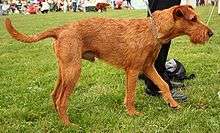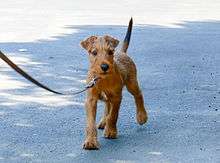Irish Terrier
 Irish Terrier | ||||||||||||||||||||||||||
| Other names | Irish Red Terrier | |||||||||||||||||||||||||
|---|---|---|---|---|---|---|---|---|---|---|---|---|---|---|---|---|---|---|---|---|---|---|---|---|---|---|
| Origin | Ireland | |||||||||||||||||||||||||
| ||||||||||||||||||||||||||
| Domestic dog (Canis lupus familiaris) | ||||||||||||||||||||||||||
The Irish Terrier (Irish: Brocaire Rua) is a dog breed from Ireland, one of many breeds of terrier. The Irish Terrier is considered one of the oldest terrier breeds. The Dublin dog show in 1873 was the first to provide a separate class for Irish Terriers. By the 1880s, Irish Terriers were the fourth most popular breed in Ireland and Britain.[1]
The Irish Terrier is an active and compactly sized dog that is suited for life in both rural and city environments. Its harsh red coat protects it from all kinds of weather.
Description

Appearance
Breed standards describe the ideal Irish Terrier as being racy, red and rectangular. Racy: an Irish Terrier should appear powerful without being sturdy or heavy. Rectangular: the outline of the Irish Terrier differs markedly from those of other terriers. The Irish Terrier's body is proportionately longer than that of the Fox Terrier, with a tendency toward racy lines but with no lack of substance. The deep chest is distinctive.
The tail is customarily docked soon after birth to approximately two-thirds of the original length. In countries where docking is prohibited, the conformation judges emphasise tail carriage. The tail should start up quite high, but it should not stick straight up or curl over the back or either side of its body. The ears are small and folded forward just above skull level. They are preferably slightly darker than the rest of the coat.
Coat and color

The Irish Terrier is coloured golden red, red wheaten, or wheaten. Dark red is often mistaken as the only correct colour, possibly because wheaten coats are often of worse quality. As with many other solid-coloured breeds, a small patch of white is allowed on the chest. No white should appear elsewhere. As an Irish Terrier grows older, grey hair may appear here and there.
The outer part of the double coat should be straight and wiry in texture, never soft, silky, curly, wavy, or woolly as might be expected in the Kerry Blue Terrier. The coat should lie flat against the skin, and, though having some length, should never be so long as to hide the true shape of the dog. There are longer hairs on the legs, but never so much as a Wire Fox Terrier or Schnauzer. That means you have to have the coat trimmed often which can be expensive.
The inner part of the coat, called the under-wool or undercoat, should also be red. The under-wool may be hard for the inexperienced eye to see. Coat should be quite dense and so that "when parted with the fingers the skin is hardly visible".[2]
A properly trimmed Irish Terrier should have some "furnishings" on legs and head. The slightly longer hair on the front legs should form even pillars, while the rear legs should only have some longer hair and not be trimmed too close to the skin. The chin is accentuated with a small beard. The beard should not be as profuse as that of a Schnauzer.
The eyes should be dark brown and quite small with a "fiery" expression. The eyes are topped with well-groomed eyebrows. The whole head should have good pigmentation.
Size
Most countries have breed descriptions that say that the Irish Terrier should not be more than 48 cm measured at the withers. However, it is not unusual to see females that are 50 cm tall or dogs that are even 53 cm (20 in). Younger generations are closer to the ideal, but there is a downside to this: when an Irish Terrier is very small and light-boned, it loses the correct racy type.
Very seldom does one see Irish Terriers that weigh only 11 to 12 kg (25–27 lb), as the original Kennel Club breed description states. 13 kg for a female dog and 15 for a male dog are acceptable.
Temperament

Irish Terriers are active dogs and need and enjoy consistent mental and physical challenges; well-trained Irish Terriers may do well at a variety of dog sports, such as dog agility. The Irish Terrier is full of life, but not hyperactive; it should be able to relax inside the house and be roused to full activity level quickly.
Irish Terriers are good with people. They have a highly developed sense of loyalty and it is important that they have a strong responsible leader, for whom they have natural respect. Most Irish Terriers love children and tolerate rough-housing to a certain extent. Irish terriers need exercise; do not get one if you are not prepared to walk it. They enjoy training, new tasks are easily mastered with food and toys working equally well as motivation. Irish terriers have less of an eagerness to please people than some other breeds but have mental ability and enjoy puzzle solving. They respond best to consistent, reward based training from a relaxed, authoritative person. As with all dog breeds, violence should never be used – instead use distraction and reward the behaviour you want. It is always best to outwit and lure. When seeking a trainer, one should look for a person who has experience with terriers.
Irish Terriers are often dominant with other dogs. As with any dog, poorly socialised individuals can start fights and early socialisation is a necessity. Most have strong guarding instincts and when these instincts are controlled, make excellent alarming watchdogs.
There are more people joining organised dog sports with their terriers. The obedience training required at a certain level in most dog sports is fairly easy, though the precision and long-lasting drive needed in the higher levels may be hard to achieve. Many Irish Terriers excel in dog agility, even though it may be hard to balance the speed, independence and precision needed in the higher levels. To date there is one Agility Champion in the US, and a handful of Finnish and Swedish Irish terriers compete at the most difficult classes.
Irish Terriers have a good nose and can learn to track either animal or human scent. Many Irish Terriers enjoy Lure Coursing, although they are not eligible for competition like sight hounds are. In Finland one Irish Terrier is a qualified Rescue Dog specialising at Sea Rescue.
History
The breed's origin is not known. It is believed to have descended from the black and tan terrier-type dogs of Britain and Ireland, just like the Kerry Blue and Irish Soft-haired Wheaten Terriers in Ireland or the Welsh, Lakeland and Scottish Terriers in Great Britain. There is also conjecture that the breed may share bloodlines with the Irish Wolfhound.[1]
F. M. Jowett writes in The Irish Terrier, 'Our Dogs' Publishing Co. Ltd., Manchester, England 1947 – 7th Edition: They are described by an old Irish writer as being the poor man's sentinel, the farmer's friend, and the gentleman's favourite...These dogs were originally bred not so much for their looks as for their working qualities and gameness, the Irish Terrier being by instinct a thorough vermin killer. They were formerly of all types and of all colours – black-and-tan, grey-and-brindle, wheaten of all shades, and red being the predominant colours. Colour or size evidently did not matter if they were hardy and game."
The proper selection process of the breed began only in the latter 19th century. They were shown now and then, sometimes in one class, sometimes in separate classes for dogs under and over 9 pounds.
The first breed club was set up in Dublin in 1879. Irish Terriers were the first members of the terrier group to be recognised by the English Kennel Club as a native Irish Breed – this happened just before the end of the 19th century. The first Irish Terriers were taken to the US in the late nineteenth century and quickly became somewhat popular.
There used to be big influential kennels in Ireland, the Great Britain and US up to the 1960s. The breed is increasingly "fashionable" as a family pet because of its fondness for children. There is ambitious breeding in many continents, including Africa (South Africa), North America, (Northern) Europe and Australia.
Care

When groomed properly, the Irish Terrier coat will protect the dog from rain and cold. A properly cared-for Irish Terrier does not shed either. The wiry coat is fairly easy to groom, pet dogs (rather than show dogs) needing stripping only once or twice a year.
The coat must be stripped by hand or a non-cutting knife to retain its weather-resistant qualities. This does not hurt the dog when done properly. Keeping the skin above the stripped section taut with the other hand helps especially where the skin is looser, i.e. belly and chest. Never cut the coat – use your fingers or a non-cutting knife. If the coat is clipped, it loses colour and becomes softer, thus losing its weather-resistant characteristics. For the same reason the coat should not be washed too often, as detergents take away the natural skin oils. Most Irish terriers only need washing when dirty.
When stripping, the coat may be "taken down" entirely to leave the dog in the undercoat until a new coat grows in. For a pet, this should be done at least twice a year. When a show-quality coat is required, it can be achieved in many ways. One is by "rolling the coat", i.e. stripping the dog every X weeks to remove any dead hair. Before a show an expert trimmer is needed to mould especially the head and legs.
Most Irish Terriers need to have their ears trained during adolescence. Otherwise the ears may stick up, roll back or hang down unaesthetically.
Health

Irish Terrier is a generally healthy breed. The life expectancy is around 13 – 14 years.
The proportions are not exaggerated in any way and thus eye or breathing problems are rare. Most Irish Terriers do not show signs of allergies towards foods. As they are small dogs, the breed has a very low incidence of hip dysplasia.
In the 1960s and 1970s there were problems with hyperkeratosis, a disease causing corny pads and severe pain. Today it is widely known which dogs carried the disease and respectable breeders do not use those bloodlines any more. A health study conducted by the Irish Terrier Club of America showed a greater-than-expected incidence of hypothyroidism and cataracts. There are not enough eye-checked individuals to draw any conclusions.
Appearances in arts and culture
- Jack London's books Jerry of the Islands and Michael, Brother of Jerry were about Irish Terriers that, according to the bloodlines recorded in the beginning of the book, may actually have lived. The 2007 film Firehouse Dog features an Irish Terrier as the title character.
- Former Canadian Prime Minister William Lyon Mackenzie King owned several Irish Terriers (all named Pat), and had séances to "communicate" with the first Pat after the dog's death.[3]
- William Wordsworth's poem "Fidelity" was written after the death of Charles Gough, who fell from Striding Edge, Helvellyn in 1805. His body found below Red Tarn some months later by a shepherd, his body still being guarded by his Irish Terrier, Foxey. Nearby were discovered the bones of her dead puppies.
References
- 1 2 Various Authors (16 April 2013). The Irish Terrier - A Complete Anthology of the Dog. Read Books Ltd. pp. 123–. ISBN 978-1-4474-9178-1.
- ↑ Irish Terrier Club of America Breed Standard
- ↑ Pat I (1924–1941) Library and Archives Canada. Retrieved 4 May 2007
External links
| Wikimedia Commons has media related to Irish Terrier. |